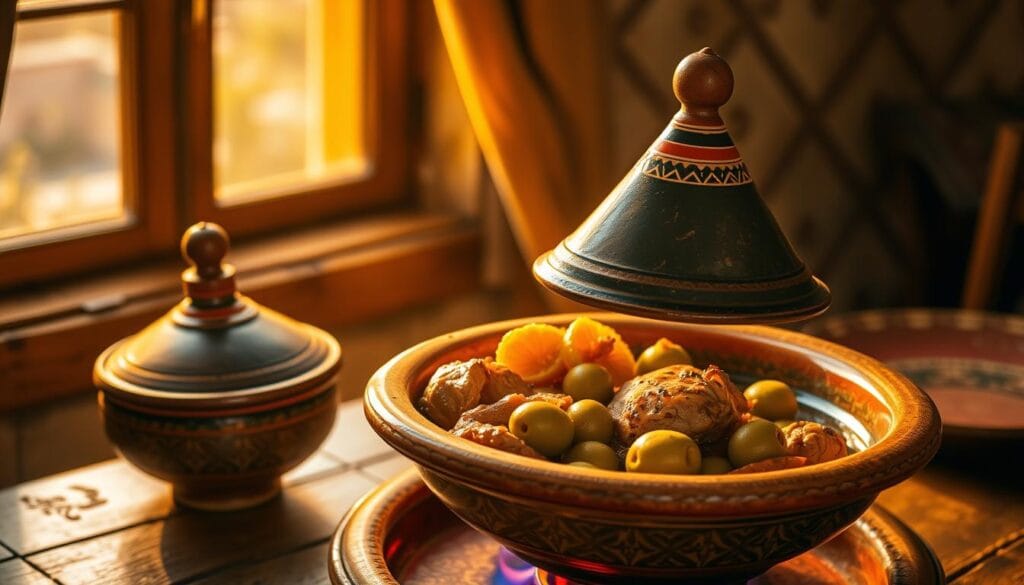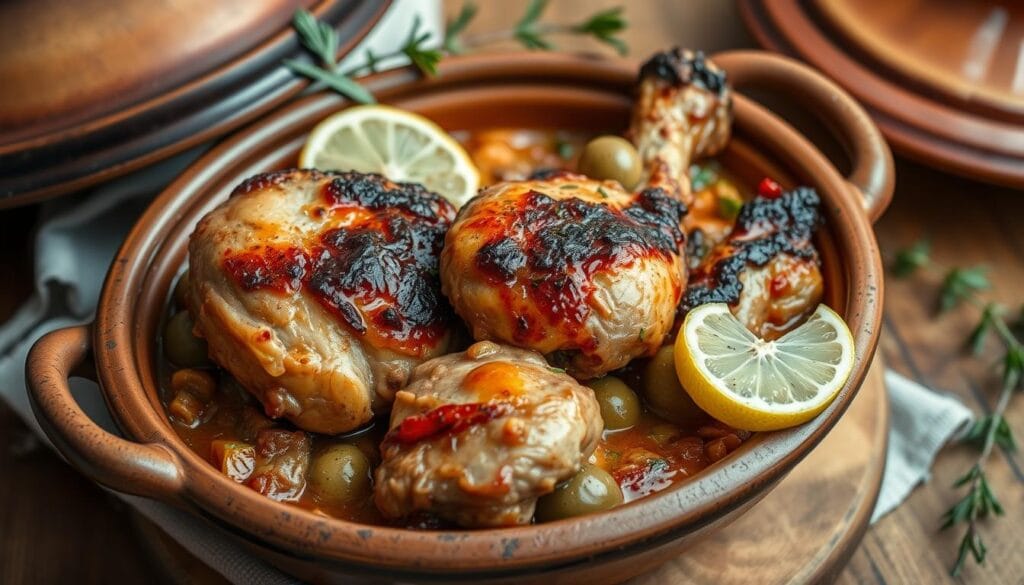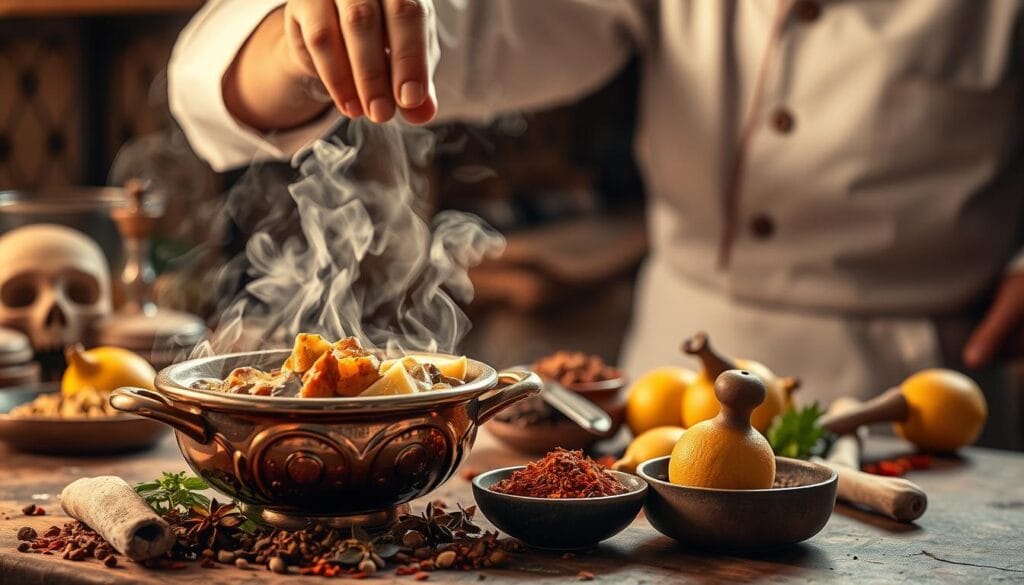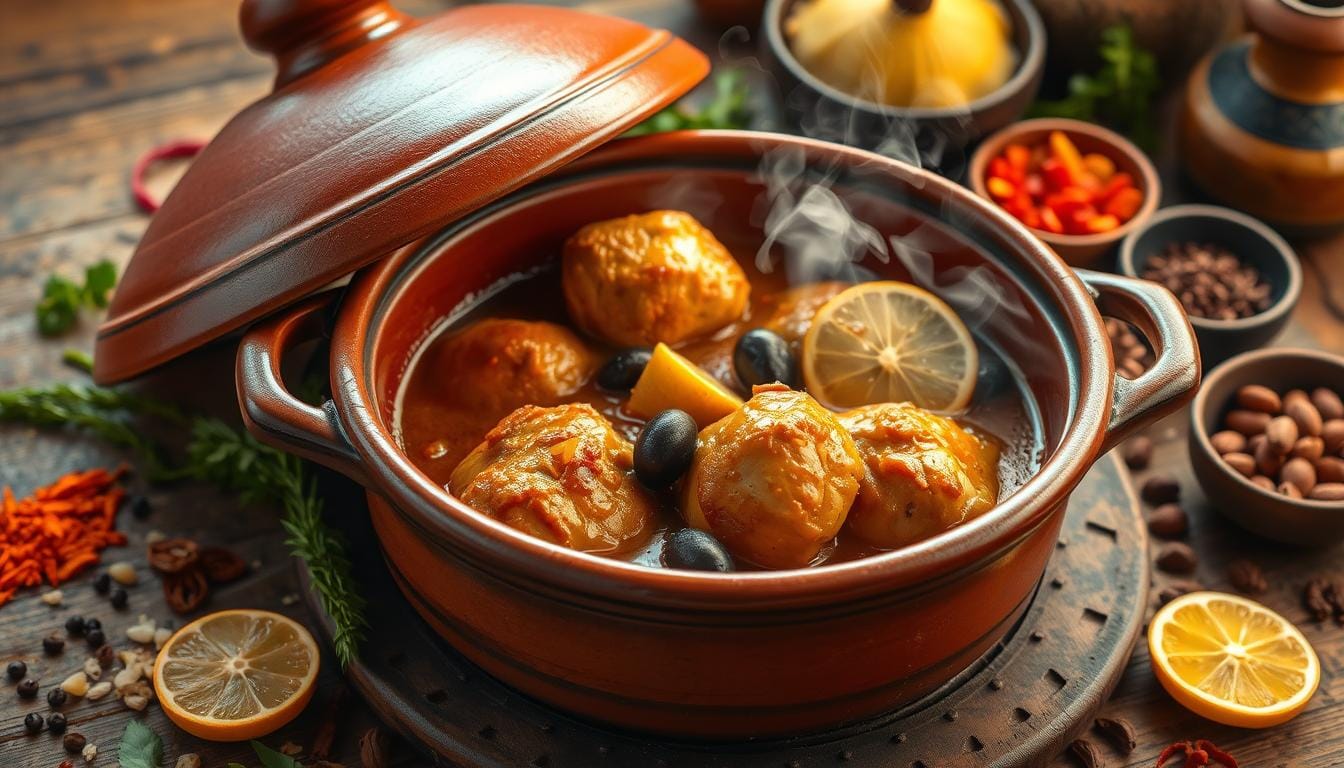The smell of Moroccan Chicken Tagine with Preserved Lemon and Olives is truly magical. It’s more than just food; it’s a warm welcome to Moroccan culture and history. Imagine your friends and family around the table, enjoying the delicious smells that fill the air.
This dish is simple yet full of flavor, making it perfect for impressing guests. Let’s start this journey together. We’ll learn how to make a Moroccan dish in your own kitchen.
Key Takeaways
- The Moroccan Chicken Tagine is a delightful introduction to traditional Moroccan food.
- This dish is known for its aromatic combination of preserved lemons and olives.
- A chicken tagine recipe is perfect for both intimate dinners and larger gatherings.
- Cooking in a tagine enhances the depth of flavors in this North African dish.
- Preparing tagine at home allows you to experience the rich cultural heritage of Morocco.
- This dish is versatile, allowing for various substitutions and variations to suit your palate.
Introduction to Moroccan Cuisine
Discover the vibrant world of Moroccan cuisine. It’s a mix of flavors that shows off rich cultural traditions. The food scene is influenced by Berber, Arab, and Mediterranean styles, making dishes unique.
When you try traditional Moroccan food, you get a mix of tastes. You’ll find both savory and sweet flavors. It’s like going on an aromatic journey.
Overview of Moroccan Flavors
Moroccan cuisine is all about Mediterranean flavors. Each dish is a journey of taste, blending ingredients in perfect harmony. You might see sweet fruits with savory meats or tangy spices with fresh veggies.
Preserved lemons, olives, and couscous are key ingredients. They add to the special taste of each meal.
Importance of Spices in Moroccan Cooking
Spices are vital in Moroccan cooking, adding depth and complexity. Cumin, coriander, and cinnamon are essential, giving dishes flavor and cultural identity. These spices make simple ingredients unforgettable.
The way herbs and spices are used in Moroccan dishes is impressive. It makes you appreciate the art of cooking and enjoy the flavors.
What is a Tagine?
A tagine is a traditional Moroccan dish and the special pot used to cook it. This cooking method has been around for centuries. It combines slow cooking with a mix of spices, meats, and vegetables, creating a delicious meal.
The History of Tagine Cooking
Tagine cooking has its roots in North Africa. It was created to keep food moist and flavorful. Over time, different regions added their own twists, making it a key part of Moroccan cuisine.
This dish is more than just food; it’s a symbol of Moroccan culture. It represents hospitality and brings people together.
Materials Used in Traditional Tagines
Traditional tagines are made from clay. They have a conical lid that helps steam circulate. This design keeps food moist and flavorful.
Today, people also use Dutch ovens or heavy braisers. These modern alternatives help keep the traditional cooking techniques alive in today’s kitchens.

Ingredients for Moroccan Chicken Tagine with Preserved Lemon and Olives
To make a delicious Moroccan Chicken Tagine, you need the right ingredients. This dish is a great choice for those who love Moroccan flavors. Here are the main ingredients and some substitutes for different tastes and availability.
Main Ingredients Explained
The main ingredients for your chicken tagine are:
- Chicken thighs: They are juicy and tender, thanks to their fat content.
- Preserved lemons: They add a unique citrus taste. Fresh lemons can be used as a substitute.
- Olives: Green or black olives add a salty flavor. Pick what you like best.
- Spices: Paprika, cumin, and ginger make the dish warm and rich. You can adjust the spices to your liking.
Substitutions and Variations
Try these substitutions to make your Moroccan Chicken Tagine even better:
- Use skinless chicken breasts for a leaner option.
- Replace preserved lemons with lemon juice and zest if needed.
- Try capers instead of olives for a salty twist.
- Add carrots or chickpeas for extra nutrition and texture.

Traditional Cooking Techniques for Tagine
Learning about traditional Moroccan cooking is key to making great chicken tagine. The braising method is a big part of this. It uses both dry and wet heat to make meat tender and sauces rich. Mastering this method can really improve your cooking.
Understanding the Braising Method
The braising method starts with browning meat in a bit of fat, then slow cooks it in liquid. This makes the meat juicy and full of flavor. As you get better at Moroccan cooking, you’ll make chicken tagine that’s tender and full of spices.
Using a Dutch Oven as a Substitute
If you don’t have a traditional tagine pot, a Dutch oven works great. Its thick walls keep heat in and moisture controlled. This lets you make a dish that’s just as good as one cooked in a tagine.

Step-by-Step Recipe for Moroccan Chicken Tagine
Making a real chicken tagine recipe is all about following the right steps. This guide will help you make this dish from Moroccan cuisine easily and with confidence.
Preparation Instructions
First, get all your ingredients and tools ready. Here’s what you need to do:
- Season the Chicken: Sprinkle salt, pepper, and spices like cumin and coriander over the chicken. Let it marinate for at least 30 minutes to soak up the flavors.
- Prepare Aromatics: Chop onions, garlic, and any other veggies you’re using. This step adds depth to your dish.
- Preheat Your Cooking Vessel: If using a tagine, warm it on low heat for 10 minutes. For a Dutch oven, use medium heat.
Cooking Instructions
Now, it’s time to cook your chicken tagine recipe.
- Brown the Chicken: Add olive oil to your hot vessel. Sear the chicken on both sides until it’s golden. This step boosts the flavor.
- Add Aromatics: Stir in the chopped onions, garlic, and veggies. Cook until they start to soften and smell great.
- Incorporate Liquid: Pour in chicken broth or water until the chicken is covered. Let it simmer.
- Add Olives and Preserved Lemons: After 30 minutes, add sliced preserved lemons and olives. This adds authentic Moroccan taste.
- Braise: Cover and let the tagine cook on low heat for 1 to 1.5 hours. Check it now and then. The chicken should be tender and full of spice.
Follow these steps to make a delicious chicken tagine. It’s a great way to enjoy Moroccan cuisine. Have fun making it and enjoy the amazing smells!
Serving Suggestions and Pairings
Enhancing your Moroccan Chicken Tagine experience is all about the right serving suggestions and drinks. Choose sides that match the dish’s rich flavors. Think fluffy couscous, barley, or roasted vegetables. These add texture and blend well with the spices found in traditional Moroccan food.
What to Serve with Tagine
When picking sides, aim for flavors that boost the dish’s taste. Here are some great options:
- Couscous tossed with herbs and lemon zest
- Barley mixed with dried fruits and nuts
- Roasted seasonal vegetables seasoned with cumin and coriander
- A simple salad with tomatoes, cucumbers, and mint
Beverage Pairings
Choosing the right drinks can make your meal even better. Here are some top picks:
- Traditional Moroccan mint tea for a refreshing contrast
- Light red wines like Pinot Noir that nicely balance the spices
- Moroccan beers such as Casablanca for a local touch
Storing and Reheating Leftovers
Enjoying Moroccan Chicken Tagine with Preserved Lemon and Olives doesn’t have to stop after one meal. Storing leftovers right can keep your dish tasty for later. Here are some tips for storing and reheating tagine to keep it delicious.
How to Store Your Tagine
Start by using airtight containers to keep your Moroccan Chicken Tagine fresh. Let it cool down before sealing to avoid sogginess. For longer storage, freeze it. Divide it into smaller portions for easy reheating.
Remember to label your containers with the date. This helps you keep track of how long it’s been stored.
Best Methods for Reheating
Reheating your tagine right is key to enjoying it like the first time. You can reheat it on the stovetop over low heat. Stir it occasionally to keep the flavors together.
Reheating in the oven is also a good choice. Preheat to 350°F, cover with foil, and warm it until hot. But, avoid the microwave to keep the chicken and olives tender.
Tips for a Successful Tagine
Cooking a flavorful tagine is more than just following a recipe. Knowing some tips for a successful tagine can make your dish pop with authentic Moroccan flavors. Learning to avoid common mistakes and using techniques to enhance flavors will make your dish come alive.
Common Mistakes to Avoid
Staying away from common mistakes is key to a perfect tagine. Here are some mistakes to avoid:
- Overcooking the chicken, which results in tough meat.
- Neglecting the balance of spices, leading to an unbalanced flavor profile.
- Using low-quality ingredients, which detracts from the dish’s overall taste.
- Skipping the marination process, where much of the flavor is developed.
Enhancing Flavor Profiles
To truly master the art of tagine cooking, consider these strategies for enhancing flavors:
- Experiment with different spice blends to suit your taste preferences.
- Incorporate fresh herbs towards the end of cooking for a burst of freshness.
- Adjust the quantity of preserved lemons or olives to increase tanginess or saltiness.
- Add a splash of honey for a sweet contrast that harmonizes all flavors.
These tips will help you make a Moroccan Chicken Tagine that delights the taste buds. By focusing on each step of the cooking process, you’ll create a dish full of rich, aromatic flavors. This dish will honor traditional Moroccan cuisine.
Conclusion
Moroccan Chicken Tagine with Preserved Lemon and Olives is a true gem of traditional Moroccan food. It showcases the bright flavors and fragrant spices that make North African cuisine special. This easy recipe shows how to balance flavors perfectly, even in your own kitchen.
Exploring Moroccan cooking means trying new things and making it your own. Moroccan Chicken Tagine is not just about following a recipe. It’s about adding your own twist and enjoying the process. Feel free to add new veggies or change the spice levels to make it your own.
Adding this recipe to your collection is more than just cooking a meal. It’s a journey into the heart of Moroccan cuisine. Let the amazing smells and tastes guide your cooking, turning your kitchen into a cozy Moroccan haven.


1 thought on “Moroccan Chicken Tagine with Preserved Lemon and Olives”
Comments are closed.